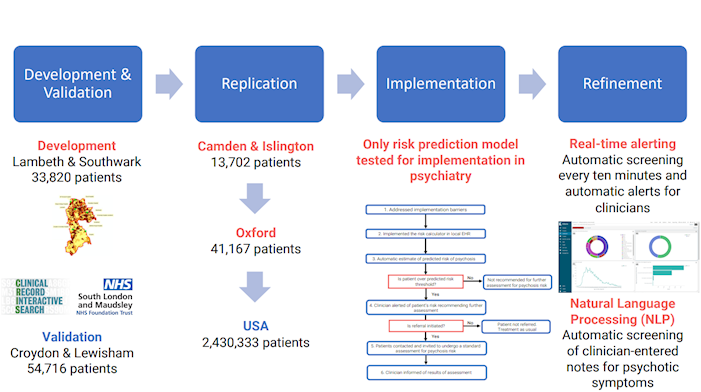Using electronic records to detect people at risk of psychosis
Before the onset of psychosis, patients pass through a ‘high risk’ phase when they experience mild symptoms for the first time. In around a quarter of these people the symptoms quickly become more severe and develop into a first ‘episode’ of a psychotic disorder, such as schizophrenia.
To date, efforts to identify young people in this vulnerable phase have mainly involved clinical services specialised for early detection such as OASIS. However, because the symptoms in these people can be difficult to recognise, many of them are referred to their general practitioner or other mental health teams, rather than early detection services.
Helping non-specialists detect risk of psychosis
To address this issue, researchers from the National Institute for Health Research (NIHR) Maudsley Biomedical Research Centre developed a tool that helps non-specialist clinicians to detect people at high risk of psychosis.
DETECT uses software from the Clinical Records Interactive Search (CRIS) system to screen information from very large numbers of patients in electronic clinical records. (See Figure below). It can be applied to both GP and mental health records. By linking it to other software, clinicians can be automatically sent an alert message if one of their patients has been identified as potentially at high risk.
Diagram: Steps taken to develop, improve and use DETECT clinically in SLaM and other mental health centres.
Implementation of real-world, real-time psychosis risk detection
The tool works well with clinical records from South London and Maudsley NHS Foundation Trust and from other mental health centres in the UK and US, and has been replicated at Camden & Islington, Oxford and the US. It is one of the first tools to have been tested for real-world use in mental healthcare.
DETECT makes it easier for people at high risk of psychosis to access specialist care that can relieve their symptoms and reduce the risk of progression to psychosis. We plan to use it to improve access to the OASIS service in South London and Maudsley NHS Foundation Trust, and then roll it out to other NHS Trusts (East London, Oxleas), and other centres worldwide.
IMPACT AREAS:
Novel Diagnostics and Therapeutics | Data and Analytics to Drive Healthcare






